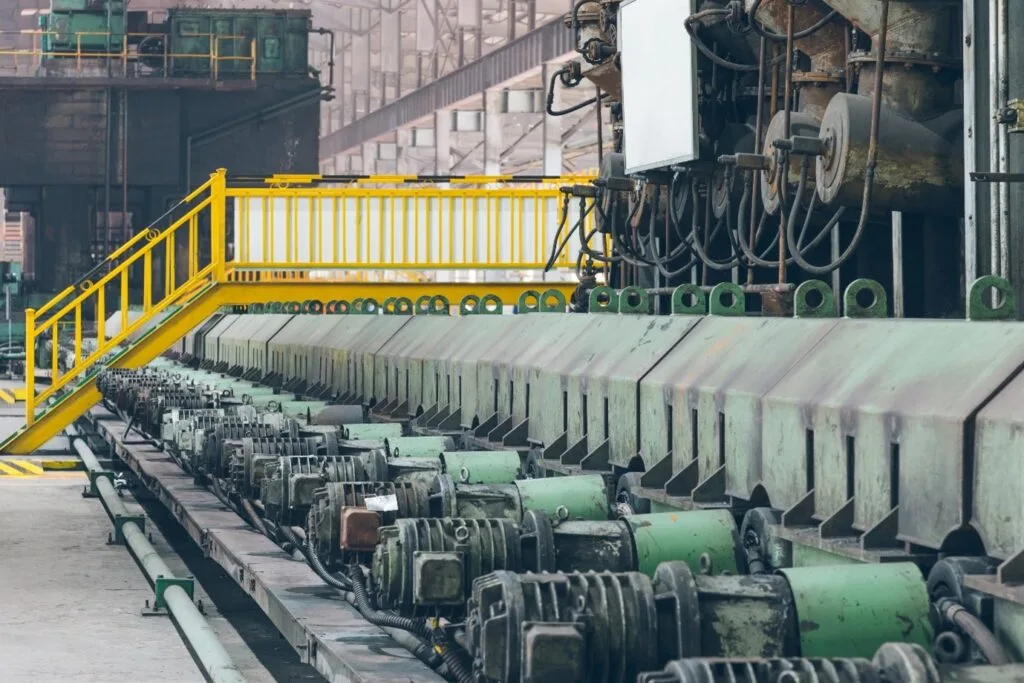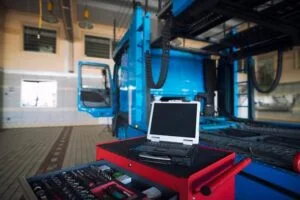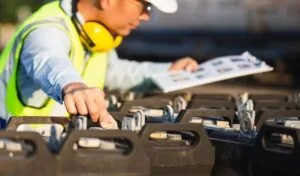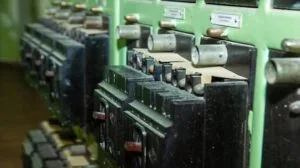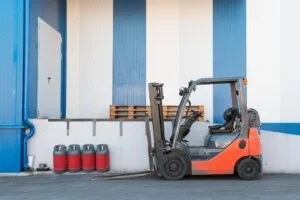In the world of industrial equipment, energy efficiency is essential. Not only does it reduce costs, but it also helps improve operational sustainability and reduces the environmental impact of your operations. Whether you’re powering forklift fleets, backup generators, or other heavy-duty machinery, choosing the right energy-efficient industrial batteries can make a significant difference.
In this blog, we’ll explore the top 5 energy-efficient industrial batteries that are perfect for heavy-duty equipment. From advanced technologies to durable designs, we’ll break down what makes these batteries stand out. And, of course, we’ll highlight how Industrial Batteries Accessories Ltd. provides high-performance solutions that help your operations run smoothly and efficiently.
Why Energy Efficiency Matters in Industrial Batteries
Before we look at the best energy-efficient industrial batteries, it’s important to understand why energy efficiency is so crucial. Using batteries that consume less power while providing reliable performance can lead to significant savings. Some of the benefits of choosing energy-efficient batteries for industrial applications include:
- Lower Operational Costs: Energy-efficient batteries require less power to operate, reducing electricity costs.
- Longer Battery Life: These batteries tend to last longer and perform better, helping to lower replacement and maintenance costs.
- Reduced Environmental Impact: With less energy consumption, these batteries produce fewer carbon emissions, making them more eco-friendly.
- Increased Productivity: Batteries that charge and discharge more efficiently help to minimize downtime, improving overall productivity.
Now, let’s take a closer look at the top 5 energy-efficient batteries that are ideal for powering heavy-duty equipment.
1. Quasar Thin Plate Gel (TPG) Batteries
Best for: Forklifts, Aerial Work Platforms, and Other Heavy-Duty Equipment
Energy Efficiency: High efficiency with low energy loss
Why it’s great:
The Quasar Thin Plate Gel (TPG) battery is an excellent choice for industries that require powerful, energy-efficient batteries. These gel batteries use advanced technology to prevent energy loss, ensuring that more of the energy is stored and used efficiently. With a gel electrolyte, the TPG battery offers longer life cycles and minimal maintenance, making it both energy-efficient and cost-effective.
Key Features:
- Low self-discharge rate: More energy stays within the battery, reducing energy waste.
- Maintenance-free: No need to check or refill water levels, saving both time and money.
- Deep discharge capability: Can handle deep discharges without damaging the battery, ensuring longer life.
| Feature | Quasar Thin Plate Gel Battery |
| Energy Efficiency | High |
| Lifespan | Long |
| Maintenance | Minimal |
| Best for | Forklifts, Heavy-duty Equipment |
2. Flooded Lead Acid Batteries
Best for: High-demand, Cost-sensitive Operations
Energy Efficiency: Good, with occasional maintenance required
Why it’s great:
Flooded Lead Acid Batteries are the traditional workhorse in industrial environments. Despite being a more affordable option upfront, they are still quite energy-efficient. When properly maintained, they deliver consistent performance, ensuring minimal downtime. These batteries are a great choice for businesses that prioritize cost savings and reliability.
Key Features:
- Cost-effective: Lower initial cost than most other industrial battery types.
- Energy-efficient for the price: Despite requiring regular maintenance, they provide solid energy efficiency for heavy-duty equipment.
- Durable: When maintained properly, they last a long time.
| Feature | Flooded Lead Acid Battery |
| Energy Efficiency | Good |
| Lifespan | Moderate |
| Maintenance | Regular |
| Best for | Cost-sensitive operations |
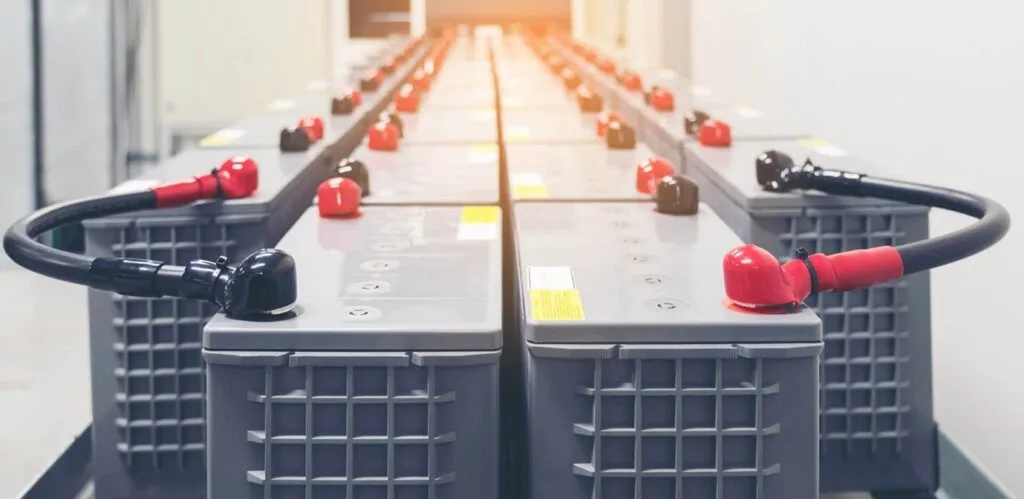
3. Lithium-Ion Batteries
Best for: All-purpose industrial equipment and vehicles
Energy Efficiency: Extremely high efficiency and fast charging
Why it’s great:
Lithium-Ion Batteries have quickly become the go-to solution for energy-efficient industrial applications. These batteries are known for their high energy density and extremely low self-discharge rate, which means they can store and use energy far more efficiently than other types. With a fast-charging design and a longer lifespan, these batteries help reduce operational costs and downtime.
Key Features:
- Fast charging: Lithium-ion batteries charge quickly, so your equipment can spend more time running and less time on the charger.
- No maintenance required: These batteries are completely sealed, requiring no maintenance.
- Lightweight and compact: Despite their powerful performance, they are much lighter and more compact than other batteries, saving space.
| Feature | Lithium-Ion Battery |
| Energy Efficiency | Very High |
| Lifespan | Long |
| Maintenance | None |
| Best for | Forklifts, Electric Vehicles, All-purpose Equipment |
4. AGM (Absorbent Glass Mat) Batteries
Best for: Standby power and high-power applications
Energy Efficiency: High, with consistent power delivery
Why it’s great:
AGM Batteries offer the best of both worlds: they are efficient and provide reliable, consistent power. These batteries use a fiberglass mat to absorb the electrolyte, which prevents spillage and makes them much safer for use in various industrial settings. AGM batteries offer excellent energy efficiency, long cycle life, and a lower self-discharge rate compared to flooded batteries.
Key Features:
- Excellent vibration resistance: Ideal for use in heavy-duty equipment exposed to movement and vibrations.
- Energy-efficient design: Lower self-discharge rate means more energy stays stored in the battery.
- Safer than flooded batteries: No liquid electrolyte means there’s less risk of leakage.
| Feature | AGM Battery |
| Energy Efficiency | High |
| Lifespan | Long |
| Maintenance | Low |
| Best for | Standby power, High-power equipment |
5. Nickel-Cadmium (Ni-Cd) Batteries
Best for: Extreme environments and harsh conditions
Energy Efficiency: Moderate, with high tolerance for temperature extremes
Why it’s great:
Nickel-Cadmium (Ni-Cd) Batteries may not be as energy-efficient as lithium-ion or gel batteries, but they offer excellent durability and performance in extreme conditions. They can operate effectively in very high and low temperatures, which makes them a great option for industrial applications in tough environments.
Key Features:
- Tolerant of extreme temperatures: Ni-Cd batteries perform well in high or low temperatures, making them suitable for harsh environments.
- Long lifespan: These batteries can last for many years, even in tough conditions.
- Robust performance: Ni-Cd batteries are known for their ability to endure heavy use and frequent discharges.
| Feature | Ni-Cd Battery |
| Energy Efficiency | Moderate |
| Lifespan | Very Long |
| Maintenance | Low |
| Best for | Harsh environments, Heavy-duty operations |
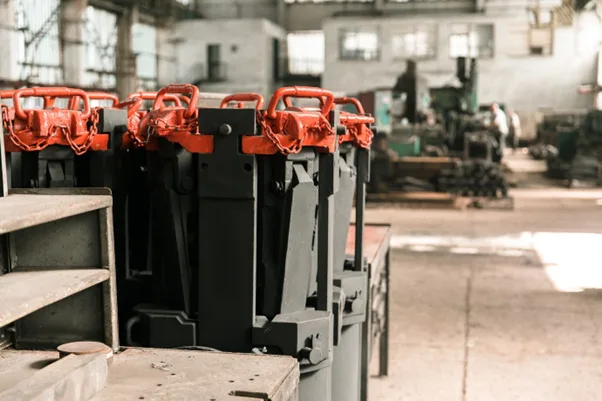
How to Choose the Right Energy-Efficient Battery for Your Needs
When choosing an energy-efficient industrial battery, it’s important to consider your specific needs. Here are a few factors to guide your decision:
- Application: Are you using the battery for forklifts, aerial work platforms, or backup power? Each application may require a different battery type.
- Cost vs. Longevity: While some batteries may have a higher upfront cost, they often provide better energy efficiency and longer lifespans, resulting in long-term savings.
- Maintenance Requirements: Some batteries are maintenance-free, while others require regular attention. Consider your team’s ability to perform maintenance when making your decision.
- Environment: Consider the temperature and working conditions where the batteries will be used. Some batteries, like Ni-Cd, perform well in extreme environments.
FAQs
1. What are the most energy-efficient batteries for industrial applications?
Lithium-ion and gel batteries are among the most energy-efficient options for industrial applications. They offer long lifespans, minimal maintenance, and excellent energy storage capabilities.
2. Are lithium-ion batteries worth the higher upfront cost?
Yes, lithium-ion batteries are worth the investment due to their long lifespan, fast charging, and energy efficiency. They can help reduce operational costs over time.
3. Can flooded lead acid batteries be considered energy-efficient?
While flooded lead acid batteries are not as energy-efficient as lithium-ion or gel batteries, they are still a good option for cost-sensitive operations and can provide reliable energy with proper maintenance.
4. How do AGM batteries compare to gel batteries?
AGM batteries are more resistant to vibration and offer excellent energy efficiency, while gel batteries tend to last longer and are more maintenance-free. The choice depends on your specific operational needs.
5. What battery is best for extreme temperatures?
Nickel-Cadmium (Ni-Cd) batteries are ideal for environments with extreme temperature fluctuations, as they perform well in both high and low temperatures.
Conclusion
Choosing the right energy-efficient industrial batteries for your heavy-duty equipment is crucial for keeping operations smooth, reducing costs, and enhancing productivity. Whether you opt for a high-tech lithium-ion battery or the more traditional flooded lead acid battery, it’s important to evaluate the energy efficiency, lifespan, and maintenance needs of each option.
By partnering with Industrial Batteries Accessories Ltd., you can find the perfect battery solution tailored to your needs, ensuring that your equipment runs efficiently and your business stays powered for the long haul.

